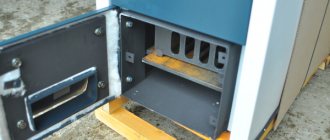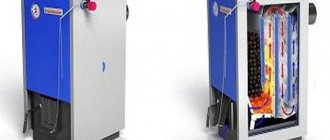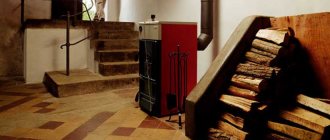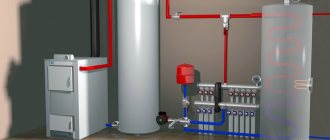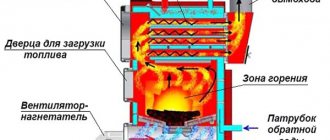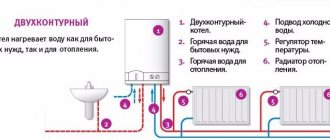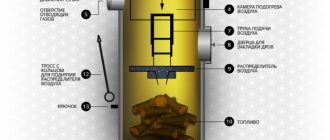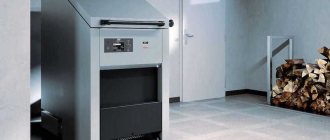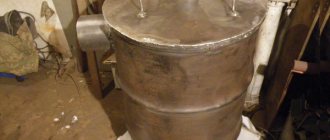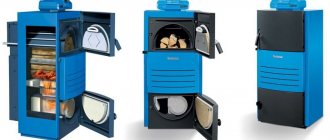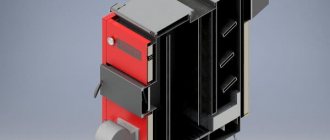Connecting the boiler (installation-piping-installation) is NOT the next stage after purchasing a solid fuel boiler, it is important to decide who will install it and how, determine it in advance, and NOT buy a solid fuel boiler without installation, especially in Minsk. After all, having bought it, you can still install it crookedly, and then what is the point of a solid fuel boiler, you should approach it with all seriousness and responsibility. Tying a solid fuel boiler requires specific knowledge, skills and abilities. It is unlikely that you will be able to tie a solid fuel boiler yourself. Yes, and this is a dangerous idea. So, if you still decide to entrust the connection of a solid fuel boiler to a specialist, then our advice: try to understand this process and at least try to understand the nuances of installing the boiler yourself (you will continue to use it for many years and operate the heating system, by the way, the boiler is firewood is most often used and has more nuances for piping).
- Preparation
- Safety
- Scheme
- Photo
- Video
- Let's summarize
Piping is a set of works to connect equipment to the engineering system (boiler piping). There are harnesses: safety harnesses for sports and for industrial mountaineering, strapping of the foundation with boards.
We will try to list some of the nuances when connecting a solid fuel boiler. Installation of heating boilers begins with preparing the floor and removing smoke:
- preparing the base for installing a solid fuel boiler - it must be strictly horizontal. Because Since a solid fuel boiler weighs a lot, the floor screed poured under it should be 7-10 cm. The dimensions of the base should correspond to the dimensions of the boiler, increased by 10%.
- Also, any heating boiler (except electric) requires a chimney to be connected. It can be either indoors (not insulated) and exit vertically through the roof, or initially exit horizontally through the wall and rise along the wall of the house above the ridge (insulated). Any chimney must be cleaned annually and its condition monitored.
Bestseller!
How to properly tie a solid fuel boiler
Piping a solid fuel boiler requires ensuring certain safety measures for the heating system:
- installation of an emergency valve (or boiler safety group). If the pressure in the heating system rises, an emergency discharge of the coolant into the sewer will occur. And this will prevent the boiler from exploding.
- Installing a cooling circuit on a solid fuel boiler will protect you from the boiler exploding, as well as from the need to recharge the heating system in the case described above.
- connecting a UPS uninterruptible power supply to the boiler and pumps will allow the heating system to operate properly even during a power outage, which we often hear about in the news in many settlements in Belarus.
- According to fire regulations, connecting a solid fuel boiler must only be done with a metal pipe (ferrous metal, galvanized, stainless or carbon steel), any option will do. As for diameters, most often we connect boilers with a power of up to 30 kW with a 1 1/4″ pipe, boilers with a power of up to 50 kW - 1 1/2″, and boilers with a power of up to 100 kW - 2″ or 2 1/2″.
- In the connection diagram of a solid fuel boiler and, accordingly, when piping a solid fuel boiler, it is necessary to provide an open or closed expansion tank (depending on the heating system). The volume of the expansion tank is calculated using a simple formula:
V tank = V system: 10The connection diagram for a solid fuel boiler requires installing an expansion tank on the return line. This will extend the life of the tank membrane.
- It is advisable to connect a solid fuel boiler (with a power of up to 70-80 kW) not by welding, but by threaded connections. In the future, this will simplify the maintenance of the entire system, and will also allow you to easily replace any failed component.
- The connection diagram for a solid fuel boiler implies the presence of a thermostatic mixing valve (for steel boilers this is protection against excess condensate, and for cast iron boilers it is protection against cold return flow, under the influence of which a section of the boiler may burst).
These are just some of the nuances that you need to pay close attention to when connecting a solid fuel boiler. The safety of the home heating system is the first place heating design begins.
Conditions for efficient boiler operation
In order for the long-burning solid fuel boiler “Lavoro” to work efficiently, you must fulfill the following installation, connection, and operation conditions, which are suitable for any other solid fuel heating boilers:
1. Boiler chimney (chimney):
- must have a height no less than that specified in the technical characteristics table in the “Boiler Operation Manual”, providing the necessary draft. At least 50 cm above the ridge of the building located closer than 10 m from the chimney.
- the diameter of the chimney must necessarily be equal to the diameter of the boiler valve (choke) installed by the manufacturer on the boiler flue;
- must have a straight section upwards of at least 2 meters, from the gate of the gas generator boiler, and only after this is it possible to make one turn at 450, no more than 1.5 meters long horizontally;
- all pipes that are higher than 1 meter from the boiler valve, installed outside the insulated room, must be insulated (sandwich);
- all areas must be collected “for condensation”, i.e. each upper knee is inserted from above inside the previous lower knee (section);
- any chimney connections must be well secured to each other, sealed against air and gas flows;
- the chimney must be secured so that its weight does not put pressure on the damper of the solid fuel boiler;
- the distance (clearance) between the upper part of the head fixed above the chimney, i.e. There must be at least 15 cm between the top of the head and the top edge of the chimney.
2. You need to install a thermometer on the return line of the heating system (up to 1200C), but not closer than 1 meter from the long-burning solid fuel boiler “Lavoro”.
3. The first meter of the “direct” pipe for the coolant (water, antifreeze) heated by the boiler and the first meter of the pipe in the “return” section must be metal.
4. The power (heating capacity) of a long-burning solid fuel boiler of the Lavoro brand must be no less than the necessary power required for the heated room, determined by thermal calculation or simplified calculation, which applies to heated rooms with good thermal insulation throughout the entire volume of the room with a ceiling height of no higher than 3 meters, namely 1 kW per 10 m2.
5. The first turns of the heating system from the hot water boiler on the “direct” and “return” should be assembled with half-bends, and not with connecting turns 900. When piping a long-burning solid fuel boiler, you must try to make as few turns as possible.
6. Install the solid fuel boiler at a distance of at least 1 meter from the fence, the wall of the room to the boiler flue door (rear side of the boiler), at least 70 cm from the sides of the boiler and at least 2 meters from the front, front side of the boiler ( on which the firebox door is located) to the fences and walls of the room in which the Lavoro brand boiler is installed.
7. The gas generator boiler must be installed without tilting in any direction.
8. There should be a metal sheet in front of the long-burning heating boiler. The dimensions of the sheets are indicated in the “Boiler Operation Manual” and are determined by fire safety rules.
9. ATTENTION! You cannot heat a long-burning solid fuel boiler with an active direct combustion process for more than 12 hours a day, in order to avoid damage to the boiler (burnout of the partitions inside the combustion space, requiring their replacement; this work is not covered by the manufacturer’s warranty).
The direct combustion process in this product should be used only for the initial, fastest (in comparison with other possible combustion processes) heating of the coolant (water, antifreeze), until the temperature in the heating system required by the consumer is reached.
10. It is prohibited to extinguish burning, smoldering fuel in the furnace of a pyrolysis boiler with water. You can, for example, sand.
If you want to stop burning or smoldering fuel in the firebox of a solid fuel boiler, then it is quite enough to completely close the air supply control door and completely close the damper.
If you want to lower the temperature of the coolant, then completely close the air supply control door without changing the position of the damper; when the required reduced temperature is reached in the entire heating system, return the air supply control door to the same position in which it was before closing, in this case the temperature will be recorded , established after its decrease.
11. PROHIBITED! fire the gas generator boiler with the combustion door open. You can light small wood chips with the boiler fire door open.
12. ATTENTION! The front process window must not be opened while the Lavoro gas generator boiler is operating. You can open the door of the technological window, located behind the boiler on its gas duct, while the boiler is operating, for visual inspection of possible contamination of the upper combustion space by ash (any ash deposits in the upper combustion spaces occur only for two reasons: 1. insufficient draft, it is necessary to increase the height of the smoke pipes; 2. a chimney located outside a warm room is not insulated, it needs to be insulated.
If the above requirements are met and the heating system is installed by a specialized organization, the boiler will very quickly heat the coolant in the heating system and for 8 - 12 hours or more (depending on the quality of the fuel) will maintain the set temperature that is most comfortable for the consumer, from one most complete setting fuel.
Any non-compliance with these conditions for the installation, connection and operation of a long-burning solid fuel boiler will result in its ineffective operation, up to circumstances requiring repairs that are not included in the manufacturer’s warranty in these cases.
Any qualified welder-fitter can restore and bring into working condition damaged areas of the boiler (places of burnouts, leaks that appeared due to inappropriate operation or the fault of the manufacturer) throughout the entire service life of a solid fuel hot water heating boiler by welding onto these places (using any type of welding) of heat-resistant, corrosion-resistant metal (boiler steel).
Boiler connection diagrams for a general overview
Let's look at the wiring diagrams. Simple boiler piping includes:
- circulation pump (1) to ensure the movement of coolant (water) in the pipes and equipment of the heating system,
- the expansion tank (2) takes excess water (coolant) from the system when it is heated and releases it back into the system,
- The boiler safety group (3) with a safety valve throws excess water into the sewer when the boiler boils.
Next come the safety systems for people and the boiler itself. We protect the boiler heat exchanger from exposure to excessively cold water, which causes it to fail ahead of time. We install a 3-way thermostatic mixing valve (8) - if cold water comes from the return from the heating radiators, which is more than useful for the boiler heat exchanger, the valve will turn on the addition of hot water.
Now we protect people from explosions and burns. A feature of the piping of a solid fuel boiler is: the combustion of solid fuel in the boiler is completely uncontrollable, like in gas and electric boilers. Therefore, when connecting a heating system with a solid fuel boiler, it is imperative to prevent excessive overheating of the water to 95 degrees. in pipes and heating radiators to temperatures dangerous for human touch. And for this there are 3 separate methods of cooling water to heating radiators, which can be used simultaneously.
Option 1: The mixing valve (7) adds cooler water from the return water from the heating radiators into the pipe to the heating radiators as needed. Looks simple enough.
Option 2: 4-way emergency cooling valve of the heat exchanger (4) with a remote sensor when overheating up to 95 degrees. It will run cold water from the water supply into the boiler through the return line, and throw the superheated water from the boiler into the sewer. Since this is possible when there is a power outage in the house. The boiler pump stops, but also the pump in the well. Therefore, cold water for cooling the boiler is taken from the water supply accumulator and it may not be enough: we install an additional hydraulic accumulator (5) with a check valve (6) to disconnect it from the water supply.
Option 3: Emergency gravity circuit with check valve (9) - the diagram shows this option, however, the circuit requires specificity, a certain low pressure and temperature, and may contain a heating radiator for these purposes.
Option 4: Use several methods at the same time.
Solid fuel boiler piping
Solid fuel boiler connection diagram
The piping of a solid fuel boiler with a connection to a closed circuit of the heating system necessarily contains a boiler safety group, an expansion tank and a circulation pump. Solid fuel boilers do not have a number of safety functions; therefore, the piping of a solid fuel boiler must additionally include the specified safety systems. Safe connection of the boiler is the safety of life and health of household members and must ensure the minimum operating temperature of the coolant at the entrance to the boiler at a level of at least 60°C. The heat exchanger should not be subject to large thermal changes - this will prevent unwanted metal deformations and the formation of tar and soot in your boiler. This condition is ensured by the installation of a mixing unit. It will maintain the required coolant temperature at the inlet to the solid fuel boiler.
Installation of solid fuel boilers and piping of a solid fuel boiler should be carried out exclusively by specialists. Installing a solid fuel boiler yourself is extremely dangerous, especially since such a boiler installation will most likely not be accepted by firefighters. This material on how to connect a solid fuel boiler is intended to introduce you to the topic so that your choice and control of installation specialists is more competent.
Photo installation of heating – Minsk region, Dzerzhinsk
Heating installation: Minsk – diagram drawing, Dzerzhinsk – boiler piping on site, chimney installation. Yes, we start by drawing in pencil a diagram of the future heating system of the house with real heating equipment: solid fuel boiler SAS 58 kW, buffer tank / heat accumulator S-Tank 2000 l, expansion tank 300 l, circulation pump Grundfos 32-60. By the way, like everyone else, the client chose chimneys for the Boiler House.
The installation of a solid fuel heating boiler in the photo was carried out by Boiler House Bai, Minsk.
Closed system with two boilers
This scheme provides for parallel connection of two boilers . Particular attention is paid to group security. Instead of an open expansion tank, a closed membrane tank is installed in a special room.
The security group consists of:
- Air bleed valve.
- Safety valve to reduce pressure.
- Pressure gauge.
The binding is done according to the following scheme:
- Shut-off valves are installed at the outlets of the heat exchangers of both boilers.
- A safety group is installed with your own hands on the supply line that departs from the solid fuel device. The distance between it and the valve may be small.
- Connect the supply pipes of both boilers. In this case, before connecting, a jumper is inserted into the line that extends from the solid fuel boiler for the home (to organize a small circle). The insertion point can be located at a distance of 1-2 m from the boiler. A check flapper valve is installed at a short distance from the jumper. If the wood boiler stops working, the coolant under pressure created by the gas cylinder-operated unit will not be able to move along the supply line towards the solid fuel device.
- The supply line is connected to heating radiators located in different rooms and at different distances from each other.
- Install the return line. It should be located between the batteries and boilers. In one place it is divided into two pipes. One of them will fit the gas boiler. On it, a spring return valve is installed in front of the unit . The other pipe must be suitable for the solid fuel boiler. The above jumper is connected to it. A three-way valve is used for connection.
- Before branching the return line, it is worth installing a membrane tank and a circulation pump.
A similar scheme is used when installing universal double-circuit wood-gas heating boilers. Such units can operate on gas from a cylinder. The piping does not use pipes that fit the gas boiler or check valves.
Connecting a solid fuel and gas boiler into one system solves the issue of fuel for the owner. A single-fuel boiler is inconvenient because if you do not replenish reserves in a timely manner, you may be left without heating. Combination boilers are expensive, and if such a unit breaks down seriously, all the heating options provided in it will become unfeasible.
Perhaps you already have a solid fuel boiler, but want to switch to another one that is more convenient to use. Or the existing boiler does not have enough power, you need another one. In any of these cases, you will need to connect a solid fuel and gas boiler into one system.
